As part of our Fall entertaining series, we're introducing another collection of delicious wines- Wines of Provence. Today we're pairing our favorite rosés with Sweet Potato Ravioli and an Autumn Apple Crisp!
"The most powerful barriers are those we cannot see or feel, the ones that cannot be torn down with hammers or bombs. Instead, the most terrifying tyranny is that which is built within the human mind, whose invisible bars seal off our freedom from within. In this way, the truly oppressed man, therefore, does not even realize he is slave."
Yes, I put that in quotes but I just made it up…quoting myself, shameless, I know.
Regardless, to precisely that point, while I've taken a positive view of 'tradition' here on Living the Gourmet, comparing it to 'guardrails' that help us order our lives, or as the voice to those who came before us, tradition can sometimes create barriers that aught never to have existed in the first place.
Now, I'm not talking about 'invisible bars' that seal off freedom, I talking about a different type of tyranny altogether - the idea that Rosé Wine is strictly, or at least mostly, a summer wine. Instead, certain types of rosé are perfectly consumable year-round - in fact, in some cases they may even be preferable. But, like white after Labor Day, many chose to simply put their rosés away once the leaves start turning.
Today, we're breaking down that invisible barrier, and we're doing so with a pair of wines that I received from the Provence Wine Council, a 2016 Grand Ferrage from the Mathilde Capoutier winery, and a 2016 Coteaux D'aix En Provence from Biéler Pére & Fils. The wines are from Côtes de Provence and the Coteaux d'Aix-en-Provence appellations respectively.
Full disclosure, I was slated to receive a third bottle from the Coteaux Varois en Provence appellation, but that bottle never arrived. To supplement, I'll still give notes on the area, but alas I cannot comment on the wine itself.
The simplest way of thinking about rosé wine is a lighter bodied version of their red counterparts, filling the space between red and white wine. To understand what 'makes' most rosés, you have to first understand that the juice of red wine grapes is allowed to ferment in contact with their skin for days or even weeks at a time. Aside from imparting or 'staining' color to the wine, the grape skins also impart body, flavor, and astringency via the leeching of tannins, anthocyanins, and phenolics from the skins into the juice - the quantity of such being dependent on the varietal in question. By contrast, rosés only come into contact with the skins of their grapes for about several hours.
Naturally, the pink color and fruit or citrus profile of many Rosés, as well as the lighter body, has the effect of 'pairing by default' the wine with lighter fare and summery weather - at least according to conventional wisdom.
However, this is bit old fashioned in my opinion, a bit like the "white wine and fish" trope. For example, I doubt any serious sommelier would say that only pairings for an asyrtiko or a garnatxa blanc would be found in the sea. Doubtlessly not, in fact.
To prove this point further, both of today's Rosés are on the lighter end of the pink-spectrum, both bearing a roughly light 'peach' or 'honeyed amber' coloration, and despite this they'll perfectly paired with an autumn dish.
However, let's start off with a little background.
The Provence Wine Council represents three of Provence's eight appellations; Côtes de Provence, Coteaux d'Aix-en-Provence, and the Coteaux Varois en Provence. Taken together, these three appellations account for about ninety-five percent of the wine produced in Provence - of which about ninety percent of that wine is rosé. It's worth noting that Provence is the only region in France to devote such a high proportion of its production to rosé. However, there is wisdom behind this level of production, since 2016 was a record year for rosé, and interestingly nearly half (43%) of Provence's total exports by volume. Around half of all French rosé consumed in the US finds its origins in Provence, making it a non-to-surprising that the US is the first export market in terms of volume and value for the Wines of Provence. Naturally, this is part of why Provence is the leader in the global Rosé revival, with worldwide exports having increased by nearly a quarter in terms of volume, and nearly a third in terms of value - numbers driven largely by millennials.
With a history dating back 2,600 years, Provence is France's oldest wine region. Geographically, the Provence is quite diverse, boasting numerous mountain ranges and rolling hills, which in turn give way to well sheltered valleys. Throughout the region, shrubs such as lavender, rosemary, juniper, and thyme grow as weeds, which has the result of 'tinging' the soil, and positively effects the resulting wine. Averaging about twenty-nine hundred hours of sunlight per year, coupled with warm days and cool evenings, Provence is, more or less, a case study in the 'ideal climate' for winemaking.
The largest of the AOCs, Côtes de Provence, produces nearly eighty percent of the entire region's wine, of which more than three-quarters of that wine is rosé. Covering about eighty-five communes, and being noncontiguous, the AOC stretches from Salernes north of the Argen River to the coast of Saint-Tropez in the southeast, and then further south to the Hyeres commune, which is the center of the sub-appellation of La Londe. Hyeres is built around the Castle of St. Bernard and features crusader-era architecture in the form of the Knights Templar Tower. Given the sapphire blue of the Porqueolles beaches just a ferry ride away, and the fresh produce on offer on Ave Gambetta, it's a great little place to enjoy the South of France if the busier streets of Saint-Tropez aren't your thing.
Grenache, Mourvedre, Cinsault, Syrah and Counoise are the dominant varietals of the Côtes de Provence appellation, with a healthy offering of Cabernet Sauvignon as well. Wines produced in Côtes de Provence are considered the archetype for the region's wines, typically being full-bodied and complex, with a very pronounced aromatic profile. The rosé produced here tends to be on the lighter end of the spectrum, but often feature a crisp acidity with citrus notes.
The second largest Provence appellation, Coteaux d'Aix-en-Provence covers fifty communes, and in contrast to its larger counterpart its production is 'only' about eighty percent rosé, with the remainder being red wines with a smattering of white. The wines produced here are distinguished by the higher concentration of Cabernet Sauvignon. As a side note, many of the vineyards here are organic. The AOC surrounds the Pond of Berre, and stretches along much of the Durance River, while surrounding the western tip of the Arc River that feeds the Berre from the Mediterranean. The AOC's primary varietals include Grenache, Mourvedre, Cinsault, Syrah and Cournoise, with a healthy representation of Cabernet Sauvignon and Carignan. For the few white wines that are produced in the region, the varietals include Vermentino, Clairette, Grenache blanc, Chardonnay, and Bourboulenc. As its name suggests, the AOC is centered on the city of Aix-en-Provence, where you'll find the sort of picturesque cafes you might imagine on the postcards of a bygone era, alongside a reputed 1000 fountains scattered throughout the Cours, the Quartier Mazarin, and the Old Town.
Finally, we come to the 'Heart of Provence,' the Coteaux Varois en Provence appellation, which is located in the center of the region. Coteaux Varois en Provence is sheltered by the surrounding Sainte-Braume mountains, which have the effect of creating a sort of 'micro climate' for the area, tempering the otherwise Mediterranean influences that are a defining feature of Provence. The appellation is based around the picturesque cities of Manosque and Forcalquier, and is divided down the middle by the Durance River, with the southeastern tip of the appellation enveloping a portion of the Verdon River. Again, pink is king with almost all of the area's wine being Rosé, with roughly ten percent of the area's production being devoted to red and white wine. The primary varietals here are Cinsault, Mourvedre, Grenache and Syrah, with a secondary representation of Cabernet Sauvignon. Given the generally higher altitude of the vineyards in this appellation, the grapes benefit from slower ripening, which in turn gives the wines a decent acidity, a very expressive flavor profile, and a well textured body.
While the wine produced by each of the aforementioned appellations is overwhelming rosé, the reds and whites aught not be ignored. Speaking in the broadest of generalities, reds produced in this region tend to trail on the darker side of the spectrum, often ruby red to deep purple in coloration, and often feature a lively fruitiness composed of dark cherries, raspberry, or black currents, with ample tannins. The whites produced here tend to be very fruit-forward, often bearing aroma profiles rich in pear, exotic fruit, pineapple and fresh citrus, along with more delicate floral notes and aromas. Naturally, this means that, if you were so inclined, you could comprise your entire wine menu for the year based entirely on Provence wine and have a roster that's complete, diverse, complex, and blissfully enjoyable.
Now, onto today's bottles.
To start things off, we begin with the 2016 Grand Ferrage, courtesy of Mathilde Chapoutier via Côtes de Provence. It is a textbook Provence blend but with the addition of Cabernet Sauvignon. As stated earlier, the wine bears a light 'peach' or 'honeyed amber' coloration, and features white stone fruit or sliced peach off the top, which becomes crisper and tropic-like deeper into the glass. The aromas largely carry over to the palate to create a fruity and citrusy wine with a pronounced mineralty and a very pleasant mouthfeel.
The 2016 Coteaux D'aix En Provence from Biéler Pére & Fils, and is 60% Grenache, 20% Syrah, and 20% Cinsault. Off the top of the glass, the wine is instantly and pleasantly floral, think cut summer flowers, hints of rosewater and perhaps just a hint of wild lavender backed by citrus or perhaps fresh citrus zest, which intensifies deeper into the glass. On the palate, the wine features tangy or tart bright berry essences with surprising depth and presence for what is an otherwise light bodied wine. The finish is quite smooth and very lasting, leaving behind aromatics in the mouth and a vague acidity on the throat.
While I can easily picture both bottles as low-key aperitifs, or perhaps as 'easy drinking' after work with friends, I could also see them serving at more 'formal' occasions such as at a relaxed dinner party. Regardless, I decided I wanted to pair the wines with something decidedly seasonal, something that simply screamed 'Autumn,' and so I decided on a dish that I could safely describe as being just shy of 'heavy,' and which boasts such fall-themed flavors as cinnamon, sweet potatoes, and savory raisins.
Naturally, I'm talking about homemade ravioli topped with a fresh garden sauce, and an apple crumble cake for dessert.
First things being first, we prepare a large cast iron frying pan with olive oil, and after heating it we add in mushrooms and let them get golden. We then remove the mushrooms, and add in more olive and a bit of butter and then sauté some garlic and onions until they're fragrant. We then add in tomatoes, basil, and the seasonings listed below and let that come to a simmer on a gentle heat while we prepare the ravioli.
Start off by preparing the filling outlined below using a ricotta and egg base mixed with Romano or Parmesan cheese, fresh Italian parsley, lemon and orange zest, chopped golden raisins, salt, pepper, and brown sugar.
Now it's time for the tedious part…and for the sake of my word count, I'll say that you simply prepare the dough as described below, and then let it sit covered for about fifteen minutes before working with it. Once it's rested, then roll the dough out onto a well-floured flat surface, working the dough until it is as thin as you can possibly manage. Now, it's time to cut out the ravioli. To do this, I use a medium sized mason jar as a sort of 'cookie cutter' to form nice circular portions of dough, and set them off into pairs.
Now, to form the ravioli we use a pair of spoons to portion out teaspoon-sized helpings of the ricotta mixture into the center of one ravioli circle, then brush the outer edges of the circle with an egg wash, and then cover it with a second plain circle of dough. Then carefully press the edges of the ravioli circles together using a fork, and set it aside on a plate dusted with cornmeal. You'll want to dust the top of the ravioli with cornmeal as well so that the next layer of prepared ravioli do not stick.
Next up, bring a large pot of generously salted water to a boil - yes, it needs to be salted. Once the water is boiling, set the ravioli in the water about three to five at a time depending on how big your pot is. When the ravioli float to the top, they are done.
Once you have finished with the ravioli, portion off about three or four tablespoons of the water into your garden sauce. Then add in about two tablespoons of red wine, and a bit more olive oil, and let it continue heating for several more minutes.
Print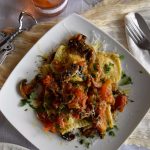
Sweet Potato Ravioli
- Total Time: 40 minutes
- Yield: 4 1x
Ingredients
Fresh Tomato Garden Sauce:
- 4 - 5 vine ripe tomatoes - diced
- 3 - 4 cloves of garlic - chopped
- 1 red onion - sliced thin
- 1 quart of button mushrooms - sliced
- 1/2 cup of fresh basil - chopped
- 3 tbs. olive oil
- 2 tbs. butter
- 2 tbs. wine
- 1 tsp. salt
- 1/2 tsp. black pepper
- 1/4 tsp. red pepper flakes
- Pinch of sugar
- 3 - 4 tbs. salted boiling water
For Ravioli Dough:
- 2 cups flour
- 1/2 tsp. salt
- 3 egg yolks
- 1 tsp. olive oil
- 1/2 cup warm water - to use by the tbs. to moisten the dough
For Sweet Potato Ravioli Filling:
- 2 cups mashed sweet potatoes
- 1 cup ricotta cheese
- 1 egg
- 1/2 cup Romano or Parmesan cheese
- 1/2 cup fresh Italian parsley - chopped
- 1 tsp. lemon zest
- 1 tsp. orange zest
- 1/4 cup of chopped golden raisins
- 1/2 tsp. salt
- 1/2 tsp. black pepper
- 1 tbs. brown sugar
Instructions
Fresh Tomato Garden Sauce:
- Heat a large cast iron frying pan with a drizzle of olive oil.
- Add the sliced mushrooms and sauté until golden on one side then flip and let the mushrooms turn golden on the other side. Remove and set aside.
- Add two tbs. of olive oil to the pan and the butter.
- Sauté the garlic and onions; sauté until the garlic is fragrant.
- Add the tomatoes, basil and seasonings and continue to simmer on a gentle heat while preparing the raviolis.
- Add the wine and a tbs. or two of the salted ravioli water to the pan and continue on a gentle heat.
For Ravioli Dough:
- Sift the flour onto a clean surface, making a well in the center.
- Place the egg yolks in the well.
- Add the salt and the egg yolks in the well.
- Add three tbs. of the water and work this mixture into the flour forming a dough.
- Knead the dough adding a tbs. of water at a time as needed until a smooth dough is formed.
- Cover the dough and let it rest for about 15 minutes before rolling out.
- Divide the dough in half and roll out one side on a lightly floured surface, as thinly as possible.
- Prepare an egg wash for the edges of the circles.
- Using a large round circle, such as a mayonnaise cover, cut out circles.
- Using a small tsp. place, the ricotta mixture in the center.
- Brush the edges with the egg wash and cover with a plain circle, ceiling the edges with a fork.
- Place on a plate dusted with cornmeal.
- Prepare a large pot of salted boiling water. When the raviolis rise to the top scoop out with a slotted spoon.
For Sweet Potato Ravioli Filling:
- Combine all the ingredients for the filling in a large bowl and mix until they are incorporated.
- Refrigerate until ready to use.
- Prep Time: 15 minutes
- Cook Time: 25 minutes
- Category: Main Dish
That, my dear readers, is the sort of recipe I like to pair my Rosé within the autumn. Dessert, of course, is a homemade apple crisp and a bubbly glass of Rosé.
Autumn Apple Crisp
Ingredients:
For the Apples:
6 - 7 medium sized apples - peeled and sliced
½ cup of granulated sugar
½ tsp. cinnamon
Dashes of fresh grated nutmeg
Zest of ½ orange
Zest of ½ lemon - plus 2 tbs. of lemon juice
Place the sliced apples in a large bowl; add the lemon zest, lemon juice and orange zest.
Combine the granulated sugar with the cinnamon and nutmeg and toss with the apples.
Butter a 9 ½ inch pie plate and add the apple mixture.
For the Crumb Topping:
1 cup of brown sugar
1 ½ cups of flour
¼ tsp. salt
8 tbs. butter - softened
Directions:
In a medium sized bowl combine the flour, salt, brown sugar and softened butter. Crumble with your fingers to form a crumb-like mixture.
Mix half of the mixture with the apples and toss.
Top the apples with the remaining crumbs. Remember if you like a lot of crumbs, like I do. Make more to place on top.
Preheat the Oven 350 degrees F.
Bake for 45 minutes or until the top is browned.
Naturally, I can wholeheartedly recommend both of the wines I received from the Provence Wine Council, not only due to their quality but also due to their versatility.
Also, if you'd like to learn more about the Wines of Provence, or to try some of them for yourself and you happen to be in the area, be sure to check out the Wines of Provence Restaurant Week in New York and San Francesco from October 2nd to 22nd, which will "Highlight the Wines of Provence rosés in Fall and winter recipes and will set the tone for the next rosé revolution."
Enjoy with Love!
1

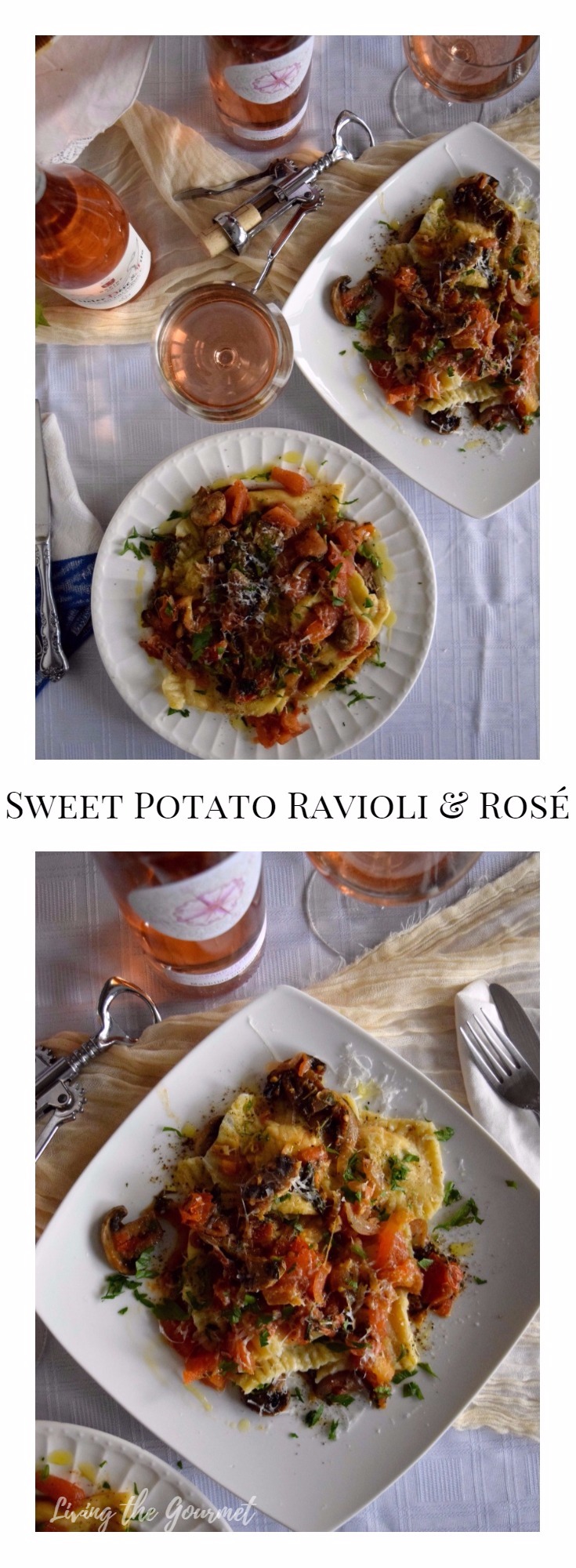
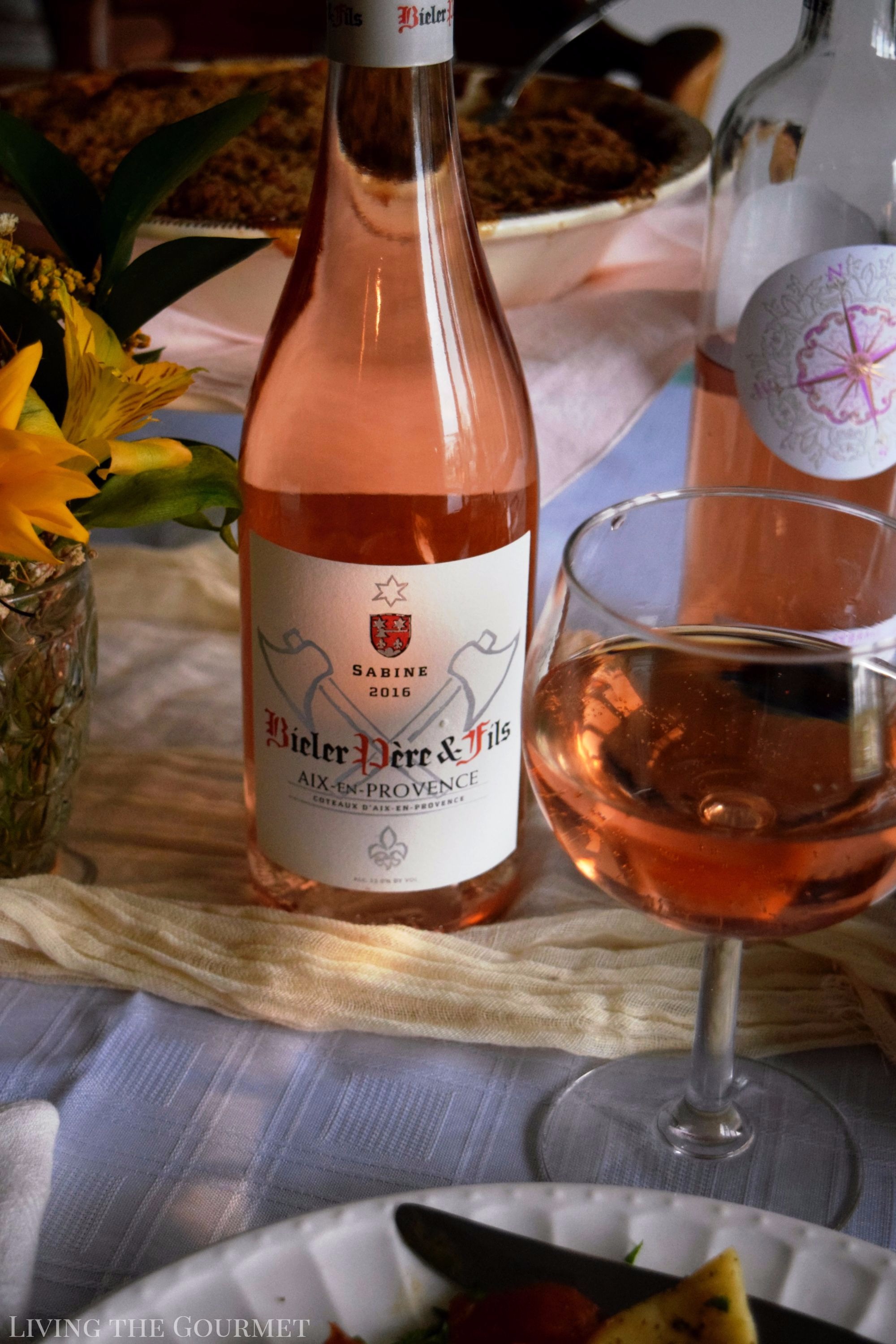
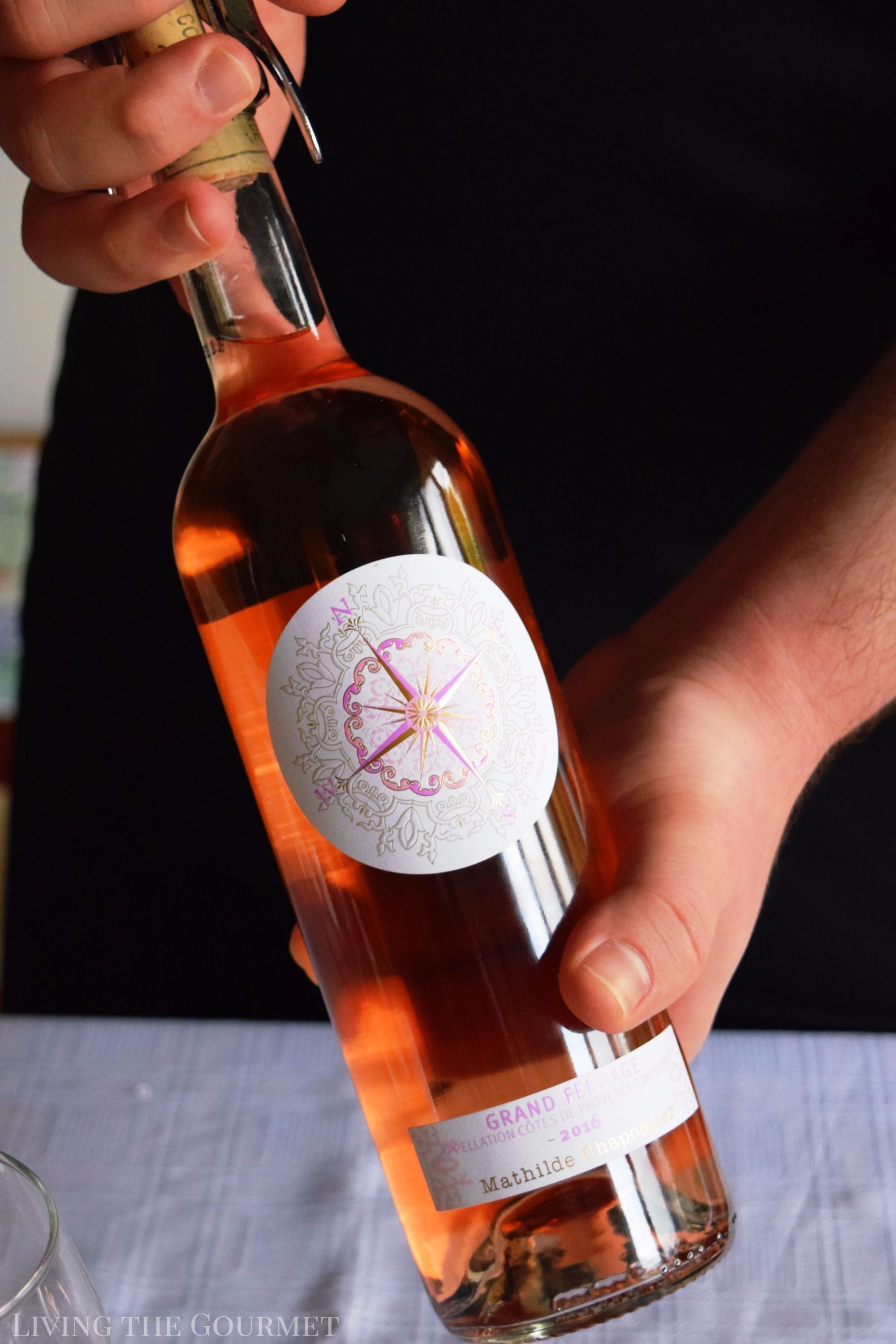

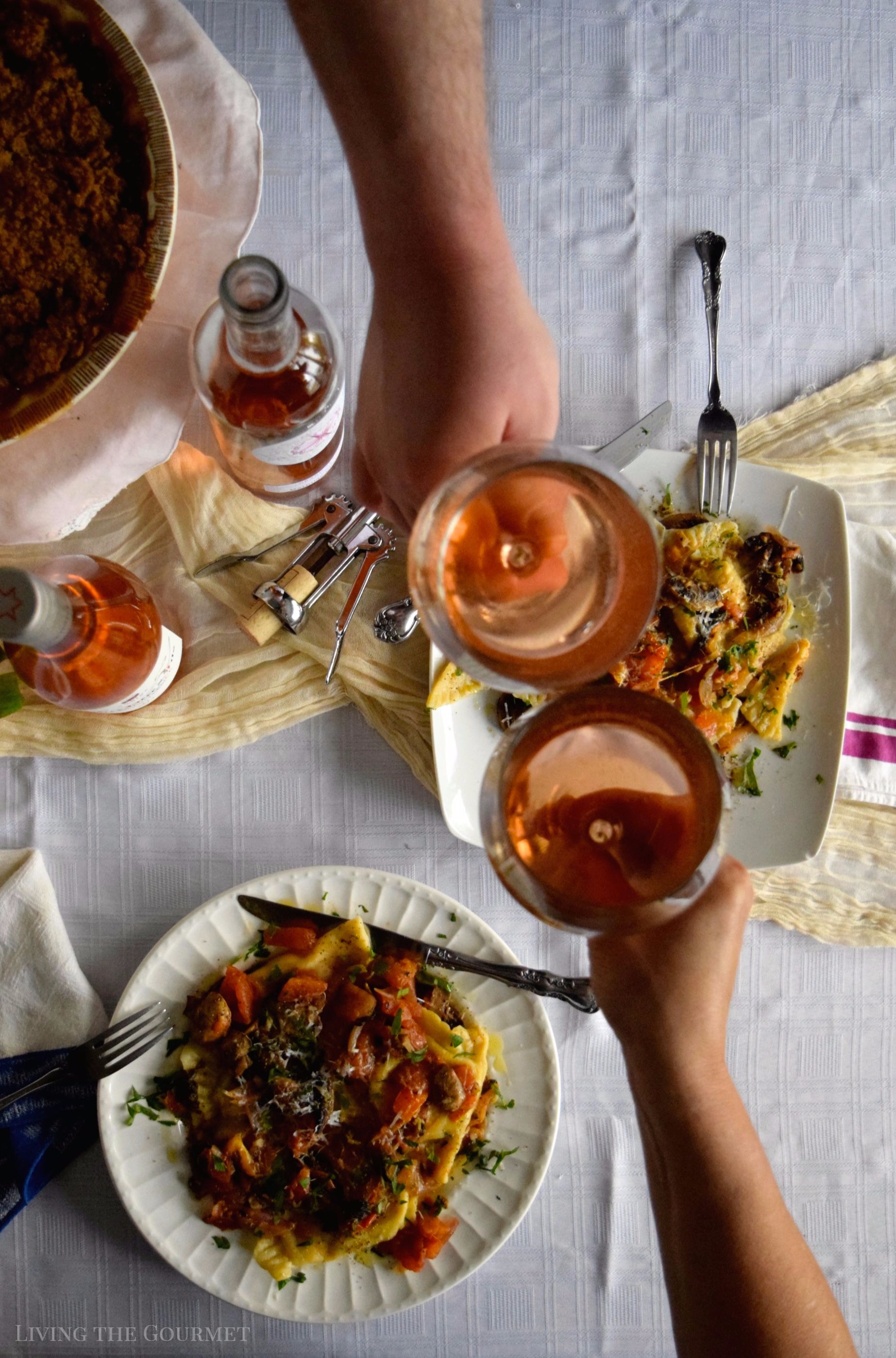
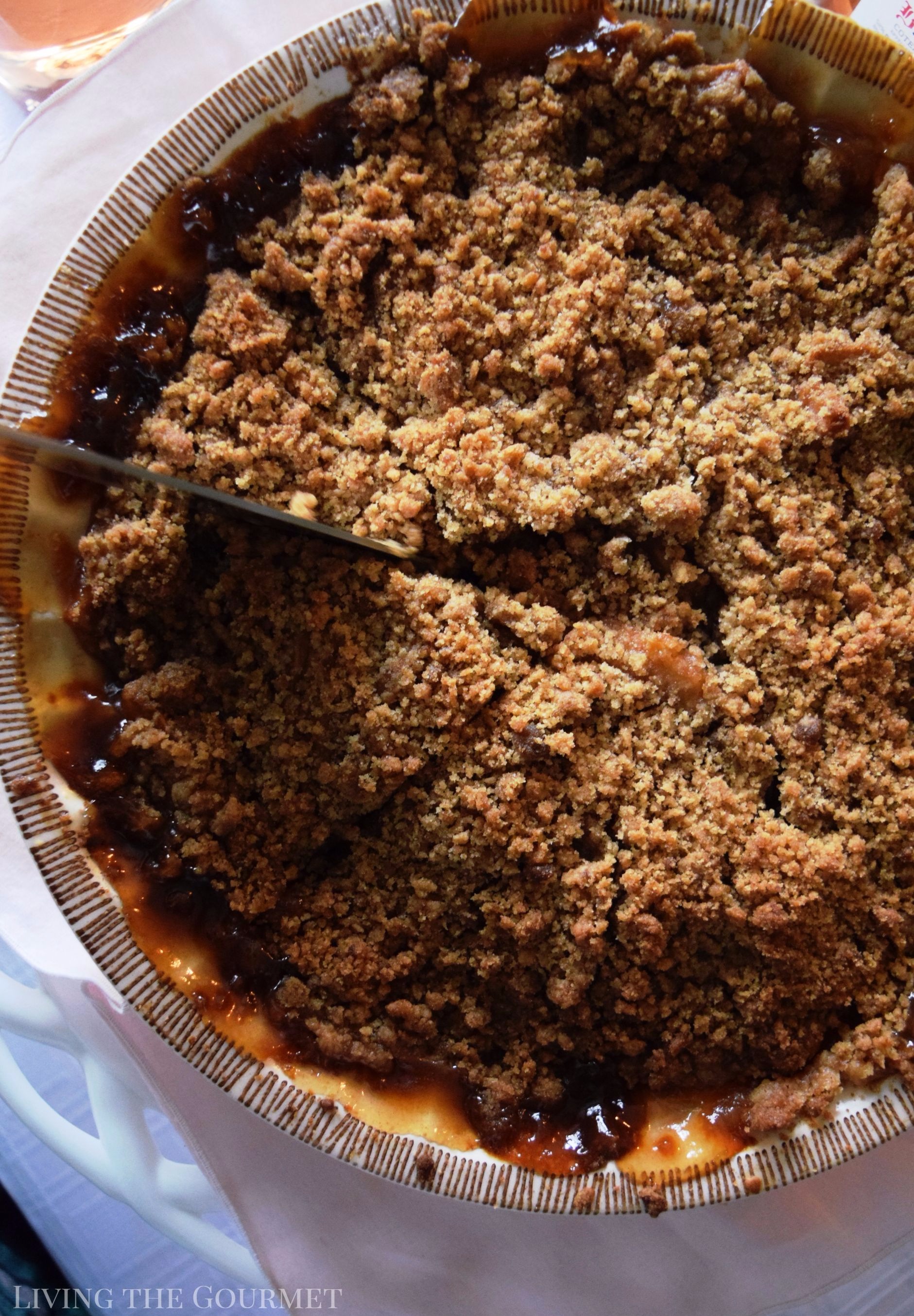
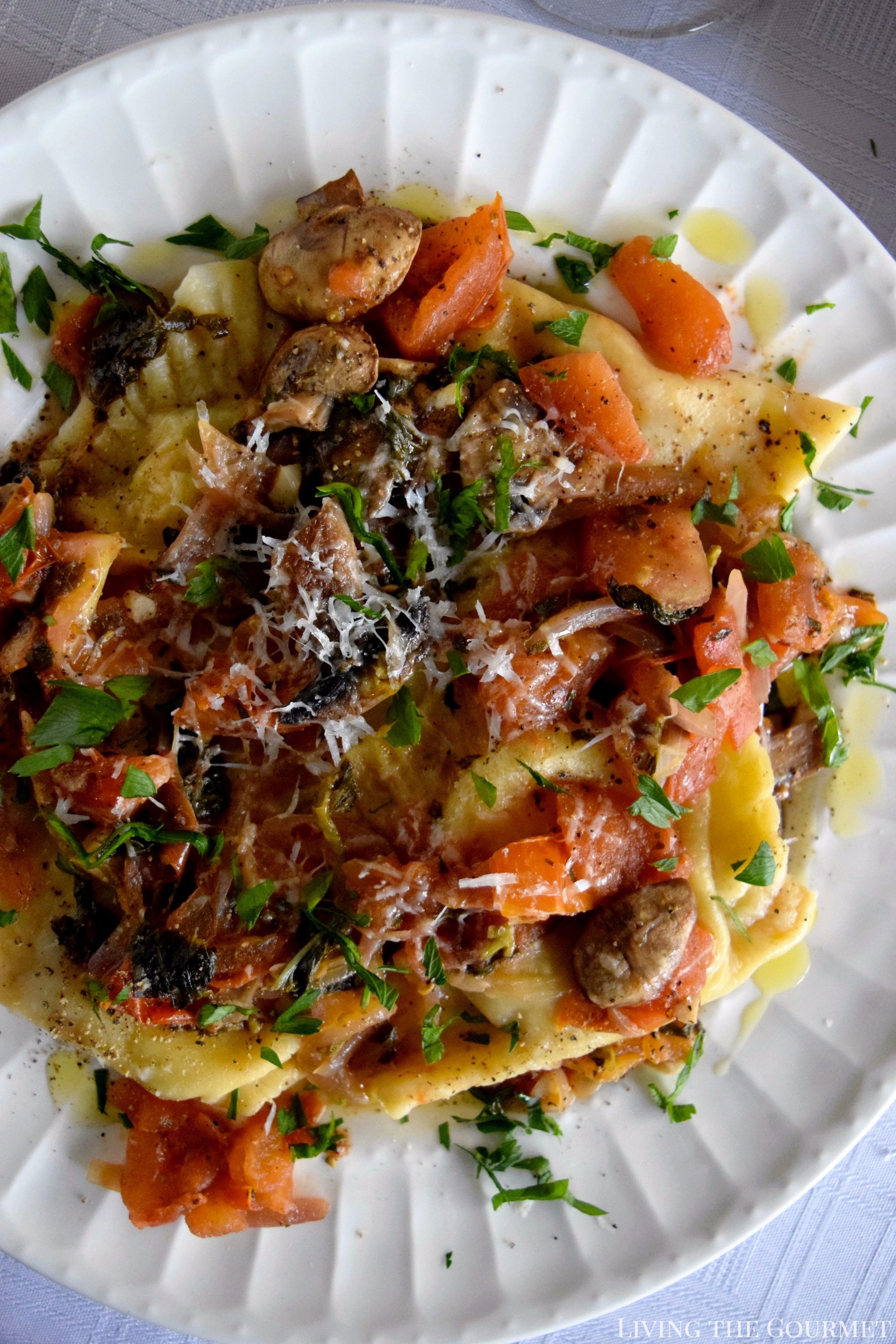
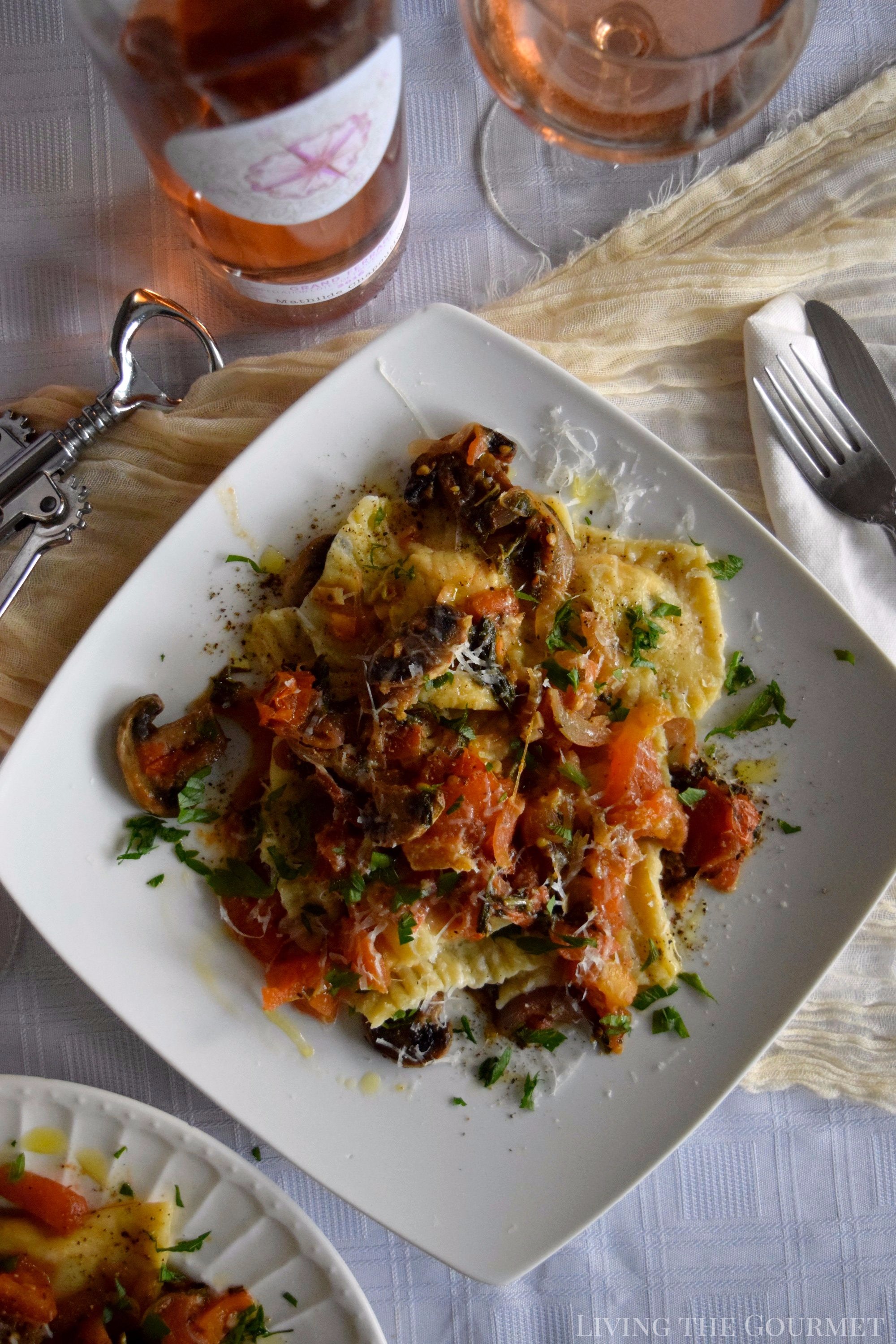
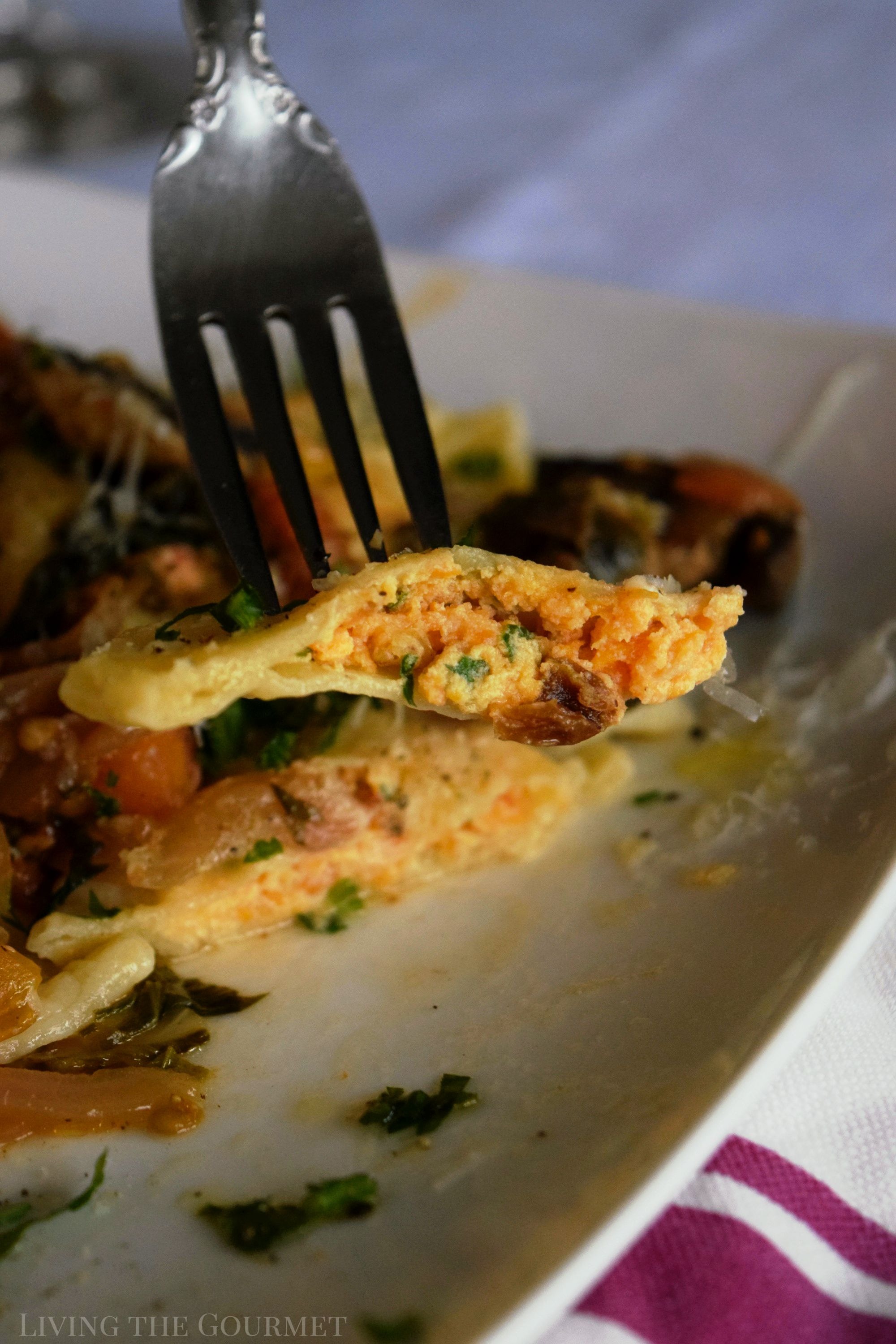
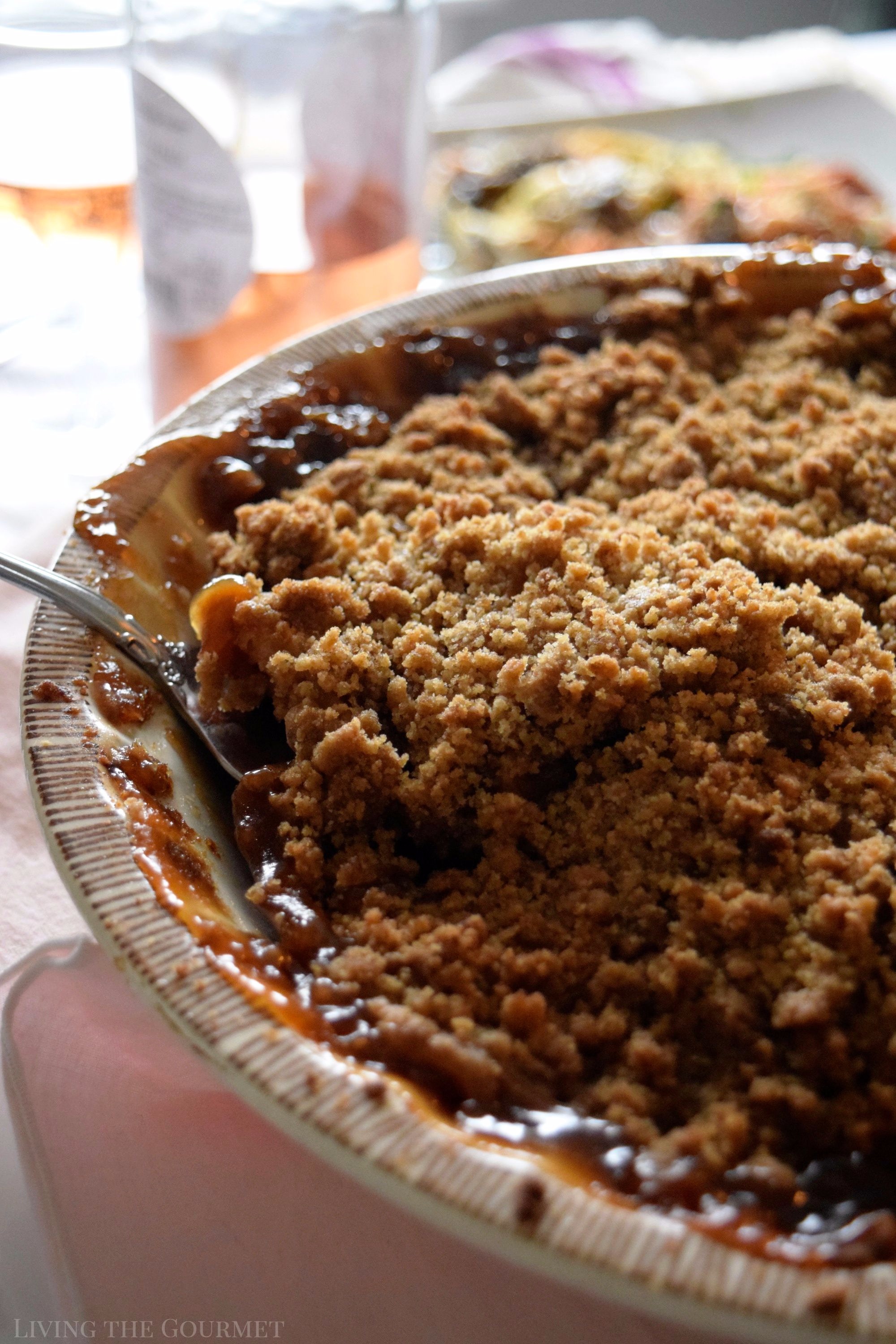
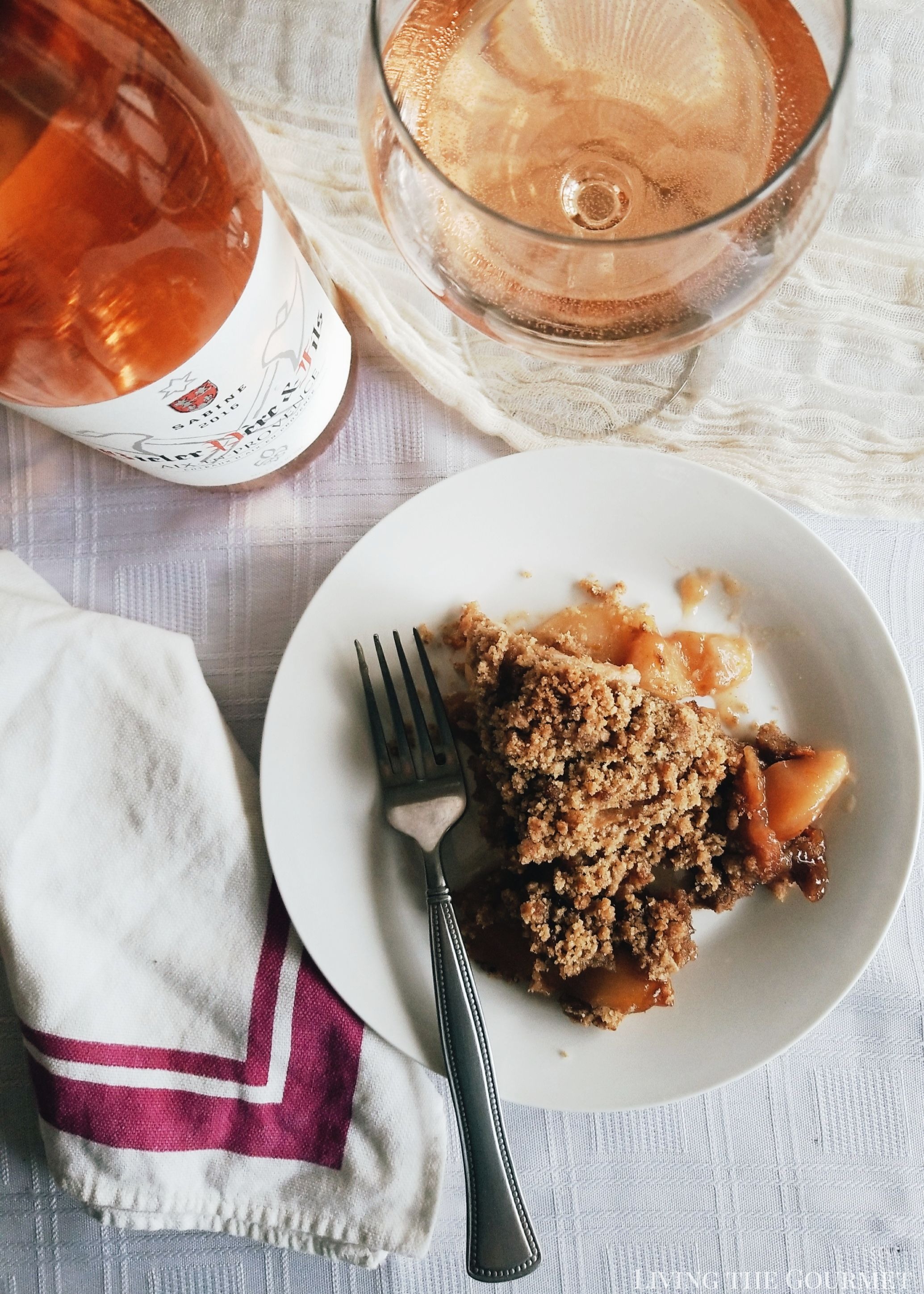
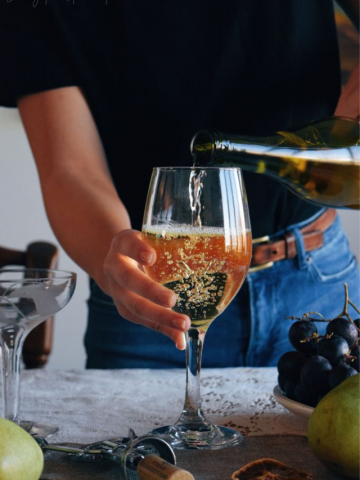
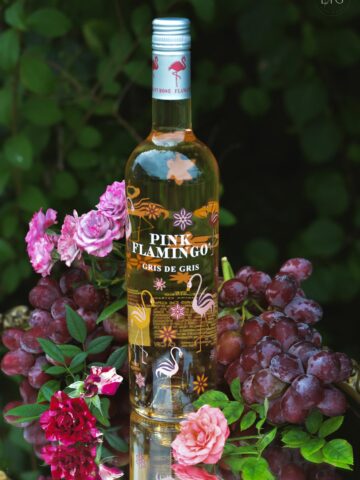
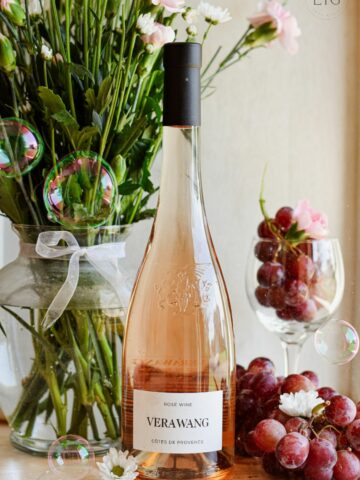
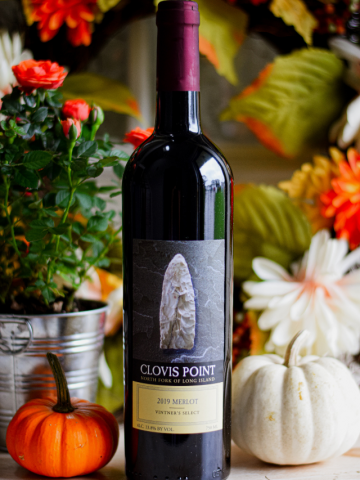
Angie@Angie's Recipes says
What a wonderful meal! I am drooling over that apple crisp!
Agness of Run Agness Run says
Yum!This dish seems so mouth-watering. Plus in combination with rose wine, it must be finger-licking. Is it possible to use yellow instead of red onion?
Chiara says
what a delicious recipe, a perfect meal ! Have a nice weekend Catherine, un abbraccio !
Adriana Lopez Martin says
wow what a meal! I love French wines and now roses are in fashion, need to try this wine from Provence must be amazing! And then the food great pairings with the subtle taste of the rose wine, yummy!
Marlynn | UrbanBlissLife says
That rosé bottle is lovely, and it sounds like a wonderful rosé to try. And I bet it does pair well with heaping forkfuls of this delicious sweet potato ravioli!
Noel Lizotte says
What a perfect at home date night meal! Elegant and formal feeling, but simple enough to pull together on a Friday night after work. Thanks for the history lesson on Rose ... I like the wine, but never knew much about it.
Joanna @ Everyday Made Fresh says
Rose wine is one of my favorites, and it sounds like it pairs perfectly with your sweet potato ravioli. I love the flavors in the sweet potato filling that you've used.
Karen (Back Road Journal) says
I never would have thought to pair a tomato based sauce with the sweet potato ravioli. Thanks for the inspiration!
Calleigh Keibler - TheForkBite says
A bubbly glass of rose is perfect for this lovely weekend get together. And it pairs perfectly with these ravioli plus the scrumptious apple pie dessert. Yum!
Andrea says
I love making ravioli, the sweet potato filling sounds absolutely delicious!
Gloria @ Homemade & Yummy says
Well you can never go wrong pairing pasta and wine. Sounds like the perfect meal to have on a weekend, and would be great to serve to guests too.
Marisa Franca @ All Our Way says
Sounds like a delicious pairing. We are in the mood for ravioli and we have a larger ravioli form that we haven't tried out yet. Can't wait to make some ravioli. "Any man who is dependent on another for his very existence is a slave." Now that was me. I could add that any man that cannot say no to another is not free. Guess we could go on and on. Italians have a tendency to be philosophical. Great recipe and pai
Debi at Life Currents says
These wines sound fantastic. And I love that you paired them with Sweet Potato Ravioli and an Autumn Apple Crisp! yummy yummy. Sounds like a perfect day!
Veena Azmanov says
OH This looks like such a feast. I love french wines too! Sweet potato ravioli is one of my favorite but I must admit I never make it at home now just because I have a local Italian deli that sells them fresh. This recipe makes me wanna make some soon.
Sandhya Ramakrishnan says
That looks like a perfect meal. Love sweet potato ravioli and the apple crisps are my weakness. Need to make them sometime soon.
swathi says
That is great meal Catherine and Tammy. I would to try both sweet potato ravioli and apple crisps with with good glass of wine. Great for entertaining.
Tina says
I love the color of rose wines! I actually never thought about it before, but it make so much sense where wine gets its color, and how to get that perfect rose color! Thanks for the explanation.
Vaughn says
i love pasta and now with sweet potato on it gonna try this
Tara says
I love all the background information you provided. The wine sounds perfect paired with that beautiful sweet potato ravioli.
Chris Collins says
You had me at sweet potato and rose! This recipe looks 100% droolworthy, must try!
Gabriel says
The perfect recipe for a successful date. This looks DELISH! This is going on my to do list!
Shashi at SavorySpin says
Dear Catherine, I love me a glass of Rosé - only (this is shameless on my part) I had no clue it was more a summery wine - thanks for teaching me something new today! And - what a delightful pairing of the rosé and that delicately prepared sweet potato ravioli and scrumptious apple crisp. By the way, so love that quote - I hope you shamelessly share more of your very own wise quotes. XOXO